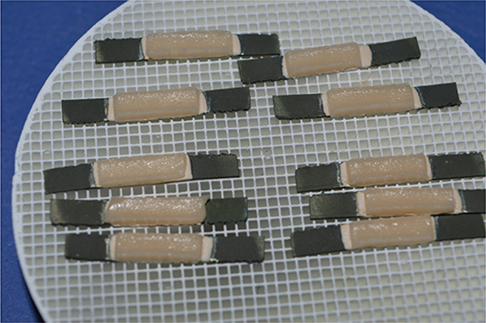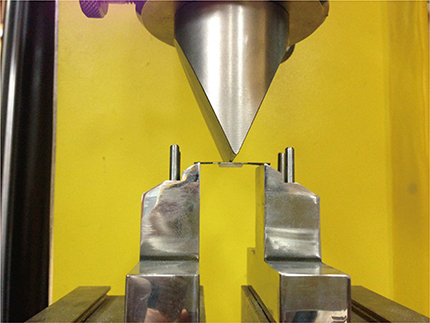J Adv Prosthodont.
2017 Feb;9(1):52-56. 10.4047/jap.2017.9.1.52.
Comparison of the bond strength of ceramics to Co-Cr alloys made by casting and selective laser melting
- Affiliations
-
- 1Prosthodontics Department, Islamic Azad University, Dental Branch, Tehran, Iran.
- 2Oral Medicine Department, Islamic Azad University, Dental Branch, Tehran, Iran. drarashazizi@yahoo.com
- KMID: 2368212
- DOI: http://doi.org/10.4047/jap.2017.9.1.52
Abstract
- PURPOSE
Considering the importance of metal-ceramic bond, the present study aimed to compare the bond strength of ceramics to cobalt-chrome (Co-Cr) alloys made by casting and selective laser melting (SLM).
MATERIALS AND METHODS
In this in-vitro experimental study, two sample groups were prepared, with one group comprising of 10 Co-Cr metal frameworks fabricated by SLM method and the other of 10 Co-Cr metal frameworks fabricated by lost wax cast method with the dimensions of 0.5 × 3 × 25 mm (following ISO standard 9693). Porcelain with the thickness of 1.1 mm was applied on a 3 × 8-mm central rectangular area of each sample. Afterwards, bond strengths of the samples were assessed with a Universal Testing Machine. Statistical analysis was performed with Kolmogorov-Smirnov test and T-test.
RESULTS
Bond strength in the conventionally cast group equaled 74.94 ± 16.06 MPa, while in SLM group, it equaled 69.02 ± 5.77 MPa. The difference was not statistically significant (P ≤ .05).
CONCLUSION
The results indicated that the bond strengths between ceramic and Co-Cr alloys made by casting and SLM methods were not statistically different.
Figure
Reference
-
1. Ferrari M, Giovannetti A, Carrabba M, Bonadeo G, Rengo C, Monticelli F, Vichi A. Fracture resistance of three porcelain-layered CAD/CAM zirconia frame designs. Dent Mater. 2014; 30:e163–e168.2. Anusavice KJ. Standardizing failure, success, and survival decisions in clinical studies of ceramic and metal-ceramic fixed dental prostheses. Dent Mater. 2012; 28:102–111.3. Gupta A, Musani S, Dugal R, Jain N, Railkar B, Mootha A. A comparison of fracture resistance of endodontically treated teeth restored with bonded partial restorations and full-coverage porcelain-fused-to-metal crowns. Int J Periodontics Restorative Dent. 2014; 34:405–411.4. Reitemeier B, Hänsel K, Kastner C, Walter MH. Metal-ceramic failure in noble metal crowns: 7-year results of a prospective clinical trial in private practices. Int J Prosthodont. 2006; 19:397–399.5. Atluri KR, Vallabhaneni TT, Tadi DP, Vadapalli SB, Tripuraneni SC, Averneni P. Comparative evaluation of metal-ceramic bond strengths of nickel chromium and cobalt chromium alloys on repeated castings: An in vitro study. J Int Oral Health. 2014; 6:99–103.6. Patel KA, Mathur S, Upadhyay S. A comparative evaluation of bond strength of feldspathic porcelain to nickel-chromium alloy, when subjected to various surface treatments: An in vitro study. J Indian Prosthodont Soc. 2015; 15:53–57.7. Lee BA, Kim OS, Vang MS, Park YJ. Effect of surface treatment on bond strength of Ti-10Ta-10Nb to low-fusing porcelain. J Prosthet Dent. 2013; 109:95–105.8. Girish PV, Dinesh U, Bhat CS, Shetty PC. Comparison of shear bond strength of metal brackets bonded to porcelain surface using different surface conditioning methods: an in vitro study. J Contemp Dent Pract. 2012; 13:487–493.9. Sadeq A, Cai Z, Woody RD, Miller AW. Effects of interfacial variables on ceramic adherence to cast and machined commercially pure titanium. J Prosthet Dent. 2003; 90:10–17.10. Tholey MJ, Swain MV, Thiel N. SEM observations of porcelain Y-TZP interface. Dent Mater. 2009; 25:857–862.11. Benetti P, Della Bona A, Kelly JR. Evaluation of thermal compatibility between core and veneer dental ceramics using shear bond strength test and contact angle measurement. Dent Mater. 2010; 26:743–750.12. Hammad IA, Talic YF. Designs of bond strength tests for metal-ceramic complexes: review of the literature. J Prosthet Dent. 1996; 75:602–608.13. Xiang N, Xin XZ, Chen J, Wei B. Metal-ceramic bond strength of Co-Cr alloy fabricated by selective laser melting. J Dent. 2012; 40:453–457.14. Akova T, Ucar Y, Tukay A, Balkaya MC, Brantley WA. Comparison of the bond strength of laser-sintered and cast base metal dental alloys to porcelain. Dent Mater. 2008; 24:1400–1404.15. Wu L, Zhu H, Gai X, Wang Y. Evaluation of the mechanical properties and porcelain bond strength of cobalt-chromium dental alloy fabricated by selective laser melting. J Prosthet Dent. 2014; 111:51–55.16. Taufall S, Eichberger M, Schmidlin PR, Stawarczyk B. Fracture load and failure types of different veneered polyetheretherketone fixed dental prostheses. Clin Oral Investig. 2016; 03. 15.17. Tan JP, Sederstrom D, Polansky JR, McLaren EA, White SN. The use of slow heating and slow cooling regimens to strengthen porcelain fused to zirconia. J Prosthet Dent. 2012; 107:163–169.18. Kannari Y, Endo K, Ida Y, Ochi M, Ohno H. Analysis of fracture surface of titanium-porcelain bonding by electron spectroscopy for chemical analysis. Dent Mater J. 2014; 33:689–695.19. Cai Z, Bunce N, Nunn ME, Okabe T. Porcelain adherence to dental cast CP titanium: effects of surface modifications. Biomaterials. 2001; 22:979–986.20. Kajima Y, Takaichi A, Nakamoto T, Kimura T, Yogo Y, Ashida M, Doi H, Nomura N, Takahashi H, Hanawa T, Wakabayashi N. Fatigue strength of Co-Cr-Mo alloy clasps prepared by selective laser melting. J Mech Behav Biomed Mater. 2016; 59:446–458.21. Bae EJ, Kim JH, Kim WC, Kim HY. Bond and fracture strength of metal-ceramic restorations formed by selective laser sintering. J Adv Prosthodont. 2014; 6:266–271.
- Full Text Links
- Actions
-
Cited
- CITED
-
- Close
- Share
- Similar articles
-
- Dental Co-Cr alloys fabricated by selective laser melting: A review article
- In vitro evaluation of the bond strength between various ceramics and cobalt-chromium alloy fabricated by selective laser sintering
- Bond and fracture strength of metal-ceramic restorations formed by selective laser sintering
- Effect of Degassing Condition on Ceramic Bond Strength of Ni-Cr Alloys
- Metal-ceramic bond strength between a feldspathic porcelain and a Co-Cr alloy fabricated with Direct Metal Laser Sintering technique



